Albert Einstein once said that there are only three constants in this universe: Death, Taxes, and the presence of Burning Abyss in the Yu-Gi-Oh! metagame.
So, how does the Divine Comedy feature in Trinity Format?
If you're unfamiliar with Trinity, you can read an Introduction about it here!
Burning Abyss: An Everlasting Constant
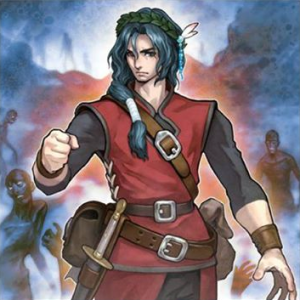 "Midway in out life journey I came to: In the midst of a dark, and dangerous wood..."
"Midway in out life journey I came to: In the midst of a dark, and dangerous wood..."Even though the deck in the TCG is over 3 years old, it still somehow manages to perform at the highest level of competition (even during the recent "Tier 0" SYPRAL format). This is also true in Trinity where Burning Abyss is extremely competitive with a pure build as well as being one of the most splashable engines in the entire format.
But before I get into what the deck does in Trinity, it's important to recognize how critically a different ruleset can alter the playstyle of a deck. Upon hearing that Burning Abyss is a competitive strategy in Trinity, many people react in different ways. One of the most common responses is "BA can't be good - Trinity only lets you summon 3 times a turn!!!".
This is a pretty logical conclusion to come to: The older TCG builds of Burning Abyss are infamous for Summoning 2 or more Dante, Traveler of the Burning Abyss on the first turn of the game. This requires you to summon at least 6 monsters on the first turn (and to play multiple copies of Dante himself), which isn't always viable in Trinity due to the the Summon Limit and Card Limit. So, how can BA be anywhere near good, if you can't even perform the most basic bread-and-butter plays which BA is known for?
The answer is seen both in the reduced power level of the format,
as well as BA's ability to adapt to new environments.
In comparison to other Decks
Although Burning Abyss in Trinity can't feasibly make multiple copies of its Boss Monster on the first turn, neither can most other decks. The Summon Limit and Card Limit both affect everyone, not just the Burning Abyss players - one of the main balancing features of Trinity is seen in how it slows down every deck. Of course Burning Abyss in Trinity is weaker when compared to the TCG. But so is everything else. So, what makes BA better than those other decks?
Many decks can barely make a single Extra Deck monster on the first turn - But Burning Abyss is special, in how it can reliably make a Dante, Traveler of the Burning Abyss on the first turn pretty much every game. Got any 2 Burning Abyss monsters in hand? Turn 1 Dante. Got a Tour Guide From the Underworld or a Galaxy Worm in hand? Again, that's a turn 1 Dante. See that Speedroid Terrortop in your hand? Special Summon it, search Speedroid Taketomborg, and boom, Turn 1 Dante. The unrivaled consistency of Burning Abyss makes it a strong deck for anyone playing Trinity - newcomers and veterans alike.
Dante Loop Dante Loop Dante Loop Dante Loop Dante
So far, I've only really talked about Dante, Traveler of the Burning Abyss. But there are lots other cards in the deck - How do the maindeck Burning Abyss monsters fare in Trinity?
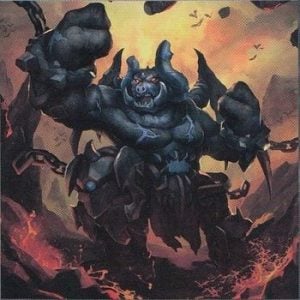 Ciriatto, Wild Hog
Ciriatto, Wild HogThe most commonly played maindeck BA card is likely Scarm, Malebranche of the Burning Abyss, simply because he can search out your Tour Guide from the Underworld, or any other BA that you need. Scarm is a great card to discard with a Raigeki Break or Paleozoic Dinomischus, in order to preserve card advantage. But Scarm isn't the best maindeck monster by any means - that title likely goes to Cir, Malebranche of the Burning Abyss.
To those not in the know, when Cir is sent to the graveyard, he's able to revive any "Burning Abyss" monster from the graveyard - that includes Dante, Traveler of the Burning Abyss. And when Dante is sent to the Graveyard, he's able to add any other "Burning Abyss" card from your graveyard to your hand - you can add back Cir.
Because of this interaction, Cir and Dante can work in tandem to create a defensive "Loop" which can obstruct the opponent turn after turn. Every turn, you can defend with Cir, who, when destroyed (usually by battle), brings back Dante - a 2500 DEF blocker. In the TCG, this might seem somewhat insignificant. 2500 DEF isn't really too much compared to any given Extra Deck monster. However, in Trinity, this is the most important setup of the Burning Abyss deck.
Without a proper response, such as a Castel, the Skyblaster Musketeer or a Compulsory Evacuation Device, the Cir/Dante loop is a nightmare to deal with. Abyss Dweller isn't really an out by itself, due to Dante's massive DEF. Even Thousand-Eyes Restrict summoned off of Instant Fusion or Magical Scientist (Which is usually a decent out to most monsters) can't deal with the Cir/Dante loop easily.
Burning Abyss as an Engine
Before, I mentioned how Burning Abyss can be splashed into any deck - The "Burning Abyss Engine" allows for any deck to have access to the Cir/Dante loop, as well as some generic Rank 3 monsters. The engine usually looks like this:
The Core Engine
- 1 Tour Guide from the Underworld
- 1 Sangan
- 1 Scarm, Malebranche of the Burning Abyss
- 1 Cir, Malebranche of the Burning Abyss
- 1 Dante, Traveler of the Burning Abyss
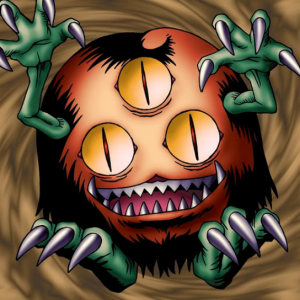 I've never been affected by the errata of this guy. It's not an issue - card is still very good.
I've never been affected by the errata of this guy. It's not an issue - card is still very good.The main premise of the Engine is to Summon Tour Guide, then use its effect to summon either Cir or Scarm from the deck. Both of them can then be used to Xyz Summon Dante or any other Rank 3 of choice. Personally, I really like Wind-Up Zenmaines, since it can get around cards like Torrential Tribute, and is often more aggressive than Dante.
However, what makes this particular subset of cards so useful is seen in how most of the cards used to search your Tour Guide - Sangan (which can also be summoned with Tour Guide) and Scarm both get you to the Tour Guide, which gets you to the Cir. Nice!
In addition to that, if you're not in the mood to make Dante (or alternatively, if you're scared of anti-Dante backrow), you can just use Tour Guide from the Underworld to summon Sangan, and end it there - Sangan can also be used to serach any other cards that you need.
Other variants of the Engine
Sometimes, it's useful to have more targets for Tour Guide in the maindeck. Without anything in the deck, Tour Guide is useless. Because of this, some of the other BA monsters sometimes see play in the engine:
- Graff, Malebranche of the Burning Abyss
- Farfa, Malebranche of the Burning Abyss
- Archfiend Eccentrick
Personally, I don't like Graff, Malebranche of the Burning Abyss in the Engine. Even though it can summon Scarm from the deck - and as a result, gives you access to Tour Guide - it's often pretty dead. Unless you're playing a lot of other Burning Abyss monsters in your deck, it's more than often useless.
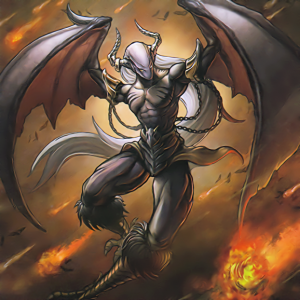 Farfarello, Goblin.
Farfarello, Goblin.On the other hand, Farfa, Malebranche of the Burning Abyss is a card that I'd highly recommend. 1900 DEF allows it to be an alright first turn set, but the ability to "turn off" an opponent's monster for a turn - or wipe off all of the Xyz materials from something like a Wind-Up Zenmaines is what we're really looking at. Allowing for both damage swings and effect "negation" making it very usable in many different decks. On top of that, when detached from an Xyz monster it can help to stop OTKS - just banish their biggest attacker.
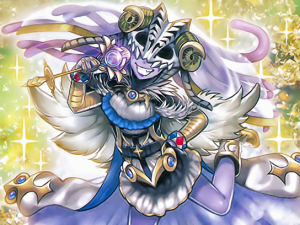 Protip: This card destroys itself when it resolves. If your opponent responds with an MST targeting this card, this card will not resolve.
Protip: This card destroys itself when it resolves. If your opponent responds with an MST targeting this card, this card will not resolve.Archfiend Eccentrick isn't a "Burning Abyss" monster, but it is a Tour guide target. As Tour Guide negates the effects of the monsters it summons, Eccentrick only acts as another target from the deck to make sure that your Tour Guide is always live. But Archfiend Eccentrick has another use - It can be used as another copy of Mystical Space Typhoon, or even monster removal! Unlike most other card in the BA engine, Archfiend Eccentrick is usually a welcome draw for any deck - The other BAs are often dead in the hand, and serve no real purpose outside of the engine. I'd even suggest Archfiend Eccentrick to be a card played in some decks not paying the BA engine (Pendulum decks especially).
Burning Abyss as a Core
So far, I've only covered the very basics of a Pure BA deck, as well as what makes it so good in other decks. So, what does a pure BA build look like in Trinity? Generally, Burning Abyss is good at doing 2 things: Milling and controlling the board.
Graveyard Synergies
There are lots of other good cards that you can cram into a deck in order to give your Dante mills more value:
- "Phantom Knight" cards
- The Phantom Knights of Silent Boots - This dude searches the PK spell/Traps for a +1:
- Phantom Knights' Fog Blade - A searchable Fiendish Chain? You know it.
- "Paleozoic" cards
- Paleozoic Canadia - Like a Book of Moon
- Paleozoic Dinomischus - Like a better Karma Cut
- Paleozoic Anomalocaris - Like a Dust Tornado
- Electromagnetic Turtle - Good value card that can protect you from OTKs.
- Necro Gardna - Worse than the Turtle, but doubles up as a level 3 monster for Xyz summons.
- Breakthrough Skill - Gets around tricky cards that want to be used on your turn.
- Lost Wind - A fine card to draw, and even better to mill.
Namely, anything that involves the Graveyard is a good call. LIGHT monsters can be splashed to allow for access to Chaos Sorcerer or maybe Black Luster Soldier - Envoy of the Beginning. You even have enough DARK monsters allow for you to play Dark Armed Dragon or The Dark Creator!
Control Synergies
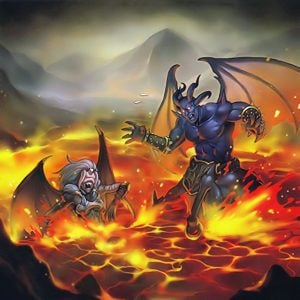 If you can resolve this a fire lake early on, you're likely going to win that game.
If you can resolve this a fire lake early on, you're likely going to win that game.If you can control the board, you can control the game. There are lots of in-archetype and out-of-archetype cards which can help achieve this.
- Fire Lake of the Burning Abyss - One of the most powerful cards in the entire game, if you can pull it off. A steep cost restricts this card from being broken, but the ability to blow up any three cards - as a Quick Effect - Makes this card an absolute blowout. Sacrificing Dante and another BA lets this card give you plusses, in addition to the mass disruption.
- Raigeki Break, Phoenix Wing Wind Blast, and Karma Cut all allow you to discard a Burning Abyss monster as a cost, for some less powerful disruption. Remember that not all BA monsters give you advantage in this way . Most of them aren't really worth the discard.
- Mask Change II can be used to summon the Semi-Forbidden Masked HERO Dark Law, a Boss Monster in his own right. Backed up with a Phantom Knight Spell/Trap, Dark Law can win a game by himself! Note that, since you'll only have 1 or 2 Mask Change II in the deck, Dark Law is much more effective in a 30- or 40- card deck than a 60-card deck.
- Absolute King Back Jack is a good tech card for any deck playing a lot of traps. It also adds to the number of cards which are useful Dante mills.
30 cards or 60 cards?
Trinity Format poses a question which exists in all card games, but is much more active in Trinity itself: Power or Consistency? Generally, 30-card decks are more consistent than 60 card decks. The probability of drawing what you want is simply much higher - especially in a (mostly) singleton format.
However, Trinity also includes incentive to play more than 30 cards - For every extra 5 cards in your deck, you can play an extra Unlimited card or a Semi-Forbidden card. Although this does reduce the consistency of most of your deck, it makes your deck that much more potent: A second Tour Guide from the Underworld, or even a second Dante, Traveler of the Burning Abyss can make your deck much, much stronger.
Burning Abyss is special, as it has so many different variants. 30-Card BA focuses on playing all of the Malebranche, and being able to use their Special Summon from hand abilities to make strong Xyz or Link monsters. 60-Card BA often contains cards like Galaxy Worm, or Speedroid Terrortop, in order to make its Rank 3 plays. They're similar, but also different. What's your playstyle? Does the idea of playing a full set of 3 Tour Guide appeal to you? It's up to you - your playstyle, your choice.
Conclusions
Make a Dante, or any other relevant Rank 3 of choice. Control the board. When you see an opening for advantage or damage, grind a little of your opponent's life points and resources away. Get value through Dante mills. Stop your opponent from getting damage through with the Cir//Dante loop.
Whether you're playing a pure build of Burning Abyss, or just splashing the engine - Do all of those, and you'll emerge again to see the stars.
Until next time - Stay groovy!




